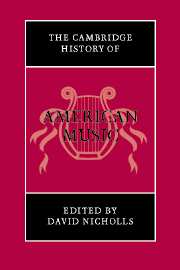Book contents
- Frontmatter
- PART ONE
- 1 American Indian musics, past and present
- 2 Music in America: an overview (part 1)
- 3 Secular music to 1800
- 4 Sacred music to 1800
- 5 African American music to 1900
- 6 Immigrant, folk, and regional musics in the nineteenth century
- 7 Nineteenth-century popular music
- 8 Art music from 1800 to 1860
- 9 Art music from 1860 to 1920
- PART TWO
- Bibliography and references
- Index
- References
9 - Art music from 1860 to 1920
from PART ONE
Published online by Cambridge University Press: 28 March 2008
- Frontmatter
- PART ONE
- 1 American Indian musics, past and present
- 2 Music in America: an overview (part 1)
- 3 Secular music to 1800
- 4 Sacred music to 1800
- 5 African American music to 1900
- 6 Immigrant, folk, and regional musics in the nineteenth century
- 7 Nineteenth-century popular music
- 8 Art music from 1800 to 1860
- 9 Art music from 1860 to 1920
- PART TWO
- Bibliography and references
- Index
- References
Summary
‘Art music, what is that?’ Music lovers and many others in the second half of the nineteenth century were confronted with a new idea, a choice and an obligation. Some music, art music, had acquired a special status, and whatever one thought, there were things one was supposed to think about it. Earlier it had been much simpler: music was either utilitarian or fun. As utilitarian it had a function, be it in church, a militia ceremony, or a public commemoration, but the event dictated its role and except for the musicians, there was nothing to ponder. Music for music’s sake, that was just a diversion, enjoyable, entertaining.
A lot of earlier nineteenth-century music had of course been serious, in either perception or intent. Church music composers sought to enhance the dignity and decorum of the worship experience in their hymns and anthems; Henry Russell’s songs moved the population to tears; and vocal groups such as the Hutchinsons stirred, inspired, and outraged the population with their moral and political topics. But only in the second half of the century did the notion spread generally through society that certain types of music were fundamentally different. This music, the argument went, had the capacity to do more than entertain; it inspired and elevated. Even though it might be instrumental and abstract, it spoke to the ethical side of humanity. Even though it might be secular, it was sacred, in an intangible way. It was moral, it was good, it was good for you. Such music was called art music.
- Type
- Chapter
- Information
- The Cambridge History of American Music , pp. 214 - 254Publisher: Cambridge University PressPrint publication year: 1998
References
- 1
- Cited by

